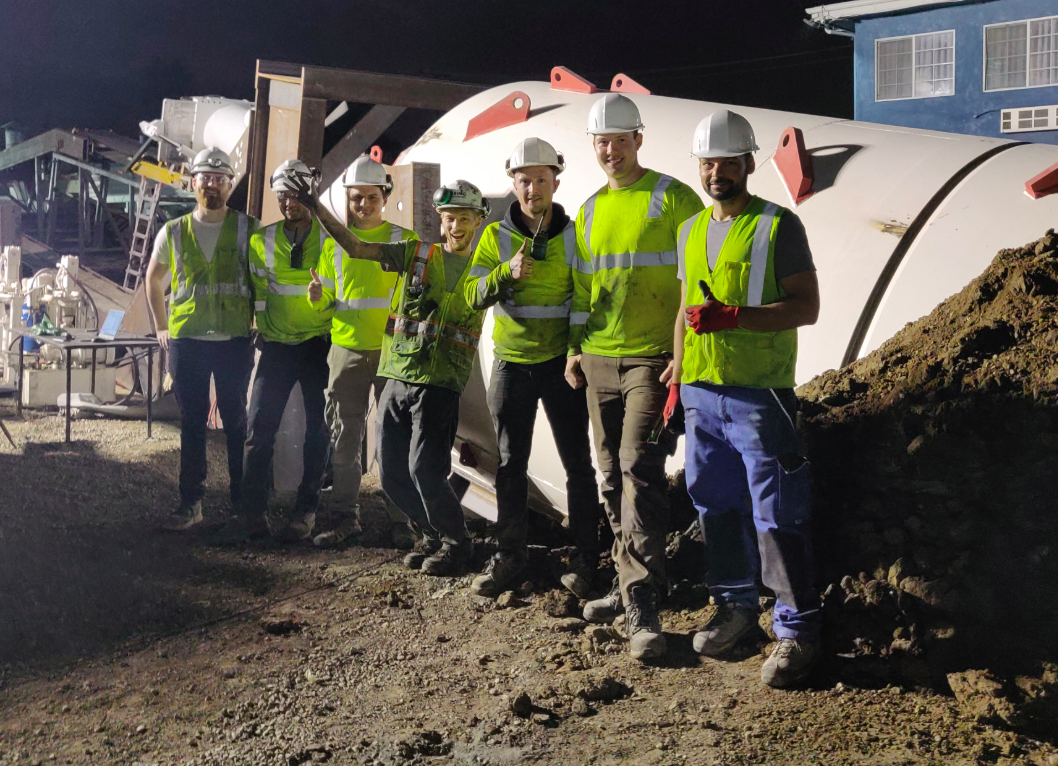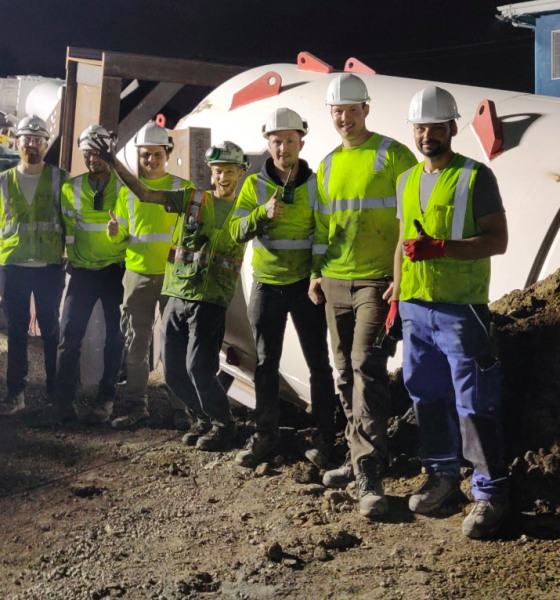

News
Elon Musk's Boring Company quietly deploys its custom-designed tunneling machine
As it turns out, Elon Musk’s tunneling startup, The Boring Company, has just completed and perhaps even deployed its custom-designed tunnel boring machine. The new digger features several innovations, and it could very well accelerate Musk’s vision of ultra-high-speed tunnels transporting vehicles and people through a vast network of tunnels underground.
The brief announcement was shared by the official Boring Company Twitter handle. The post was simple, showing a group of employees smiling in front of a tunnel boring machine that seems poised to start digging. In the tweet’s description, the startup posted the words “Prufrock is alive.”
This could very well be the biggest news to come out from the Boring Company since Elon Musk and TBC Head Steve Davis held an information session about the tunneling startup and its technologies at the Leo Baeck Temple in Los Angeles, CA back in May 2018. This is because unlike traditional tunnel boring machines (TBM), Prufrock is custom designed by The Boring Company, and it is expected to be capable of digging far quicker than its conventional counterparts.
The Boring Company started with Godot, a traditional boring machine that pretty much functions like a regular TBM. Godot is believed to be the boring machine that created the Hawthorne test tunnel, and while it works just as well as a TBM could, it is also immensely slow. Following Godot, the Boring Company designed Line-Storm, a TBM that is essentially a heavily modified conventional boring machine. In terms of speed, Line-Storm is capable of at least digging twice as fast as a traditional TBM like Godot.
But Godot and Line-Storm are just the beginning. During The Boring Company’s information session, Elon Musk and Steve Davis talked about a third tunneling machine. This machine, called Prufrock, is entirely designed by the startup, and it is expected to dig about 10-15 times faster than traditional boring machines like Godot. That’s a notable improvement over conventional diggers, and it has the potential to revolutionize tunneling technology in one fell swoop.
Elon Musk described each of the Boring Company’s TBMs as follows.
“Godot, which is the name of the first machine, is a conventional tunnel boring machine… So going from Godot to Line-Storm, Line-Storm is a highly modified boring machine, but it’s essentially a hybrid between a conventional boring machine and Prufrock, which is the fully Boring Company-designed machine. So Prufrock, that will be quite a radical change. Prufrock will be about ten times, aspirationally 15 times faster than current boring machines. I think very likely ten times.”
The Boring Company is involved in several projects, from the Dugout Loop in CA to the Las Vegas Convention Center tunnel in Nevada. Among these, the LVCC loop seems to be the most active, though the startup has not announced which of its machines had been deployed on the site. Considering that the TBM managed to complete the first of its two tunnels already, perhaps the machine digging under Las Vegas today is Line-Storm. As for Prufrock, the project where it will be deployed for the first time will likely be incredibly lucky.
The Boring Company’s potential disruption, after all, largely depends on how fast it could construct tunnels in a safe and efficient way. As noted by Elon Musk, this has a lot to do with the speed of TBMs themselves, as regular diggers move at a fraction of a snail’s pace. If The Boring Machine could at least match the speed of a snail, then a transport tunnel’s turnaround time would be drastically lower. This, of course, opens the doors to more tunnels being built, effectively ushering in Elon Musk’s vision of an ultra high-speed, underground future.

Elon Musk
GM CEO Mary Barra says she told Biden to give Tesla and Musk EV credit
“He was crediting me, and I said, ‘Actually, I think a lot of that credit goes to Elon and Tesla…You know me, Andrew. I don’t want to take credit for things.”

General Motors CEO Mary Barra said in a new interview on Wednesday that she told President Joe Biden to credit Tesla and its CEO, Elon Musk, for the widespread electric vehicle transition.
She said she told Biden this after the former President credited her and GM for leading EV efforts in the United States.
During an interview at the New York Times Dealbook Summit with Andrew Ross Sorkin, Barra said she told Biden that crediting her was essentially a mistake, and that Musk and Tesla should have been explicitly mentioned (via Business Insider):
“He was crediting me, and I said, ‘Actually, I think a lot of that credit goes to Elon and Tesla…You know me, Andrew. I don’t want to take credit for things.”
GM CEO Mary Barra said to Andrew Sorkin at the New York Times Dealbook Summit that she pulled President Biden aside and said Tesla CEO @elonmusk deserved the credit for EVs:
“He was crediting me, and I said, ‘Actually, I think a lot of that credit goes to Elon and Tesla,'” Barra… pic.twitter.com/OHBTG1QfbJ
— TESLARATI (@Teslarati) December 3, 2025
Back in 2021, President Biden visited GM’s “Factory Zero” plant in Detroit, which was the centerpiece of the company’s massive transition to EVs. The former President went on to discuss the EV industry, and claimed that GM and Barra were the true leaders who caused the change:
“In the auto industry, Detroit is leading the world in electric vehicles. You know how critical it is? Mary, I remember talking to you way back in January about the need for America to lead in electric vehicles. I can remember your dramatic announcement that by 2035, GM would be 100% electric. You changed the whole story, Mary. You did, Mary. You electrified the entire automotive industry. I’m serious. You led, and it matters.”
People were baffled by the President’s decision to highlight GM and Barra, and not Tesla and Musk, who truly started the transition to EVs. GM, Ford, and many other companies only followed in the footsteps of Tesla after it started to take market share from them.
Elon Musk and Tesla try to save legacy automakers from Déjà vu
Musk would eventually go on to talk about Biden’s words later on:
“They have so much power over the White House that they can exclude Tesla from an EV Summit. And, in case the first thing, in case that wasn’t enough, then you have President Biden with Mary Barra at a subsequent event, congratulating Mary for having led the EV revolution.”
In Q4 2021, which was shortly after Biden’s comments, Tesla delivered 300,000 EVs. GM delivered just 26.
News
Tesla Full Self-Driving shows confident navigation in heavy snow
So far, from what we’ve seen, snow has not been a huge issue for the most recent Full Self-Driving release. It seems to be acting confidently and handling even snow-covered roads with relative ease.

Tesla Full Self-Driving is getting its first taste of Winter weather for late 2025, as snow is starting to fall all across the United States.
The suite has been vastly improved after Tesla released v14 to many owners with capable hardware, and driving performance, along with overall behavior, has really been something to admire. This is by far the best version of FSD Tesla has ever released, and although there are a handful of regressions with each subsequent release, they are usually cleared up within a week or two.
Tesla is releasing a modified version of FSD v14 for Hardware 3 owners: here’s when
However, adverse weather conditions are something that Tesla will have to confront, as heavy rain, snow, and other interesting situations are bound to occur. In order for the vehicles to be fully autonomous, they will have to go through these scenarios safely and accurately.
One big issue I’ve had, especially in heavy rain, is that the camera vision might be obstructed, which will display messages that certain features’ performance might be degraded.
So far, from what we’ve seen, snow has not been a huge issue for the most recent Full Self-Driving release. It seems to be acting confidently and handling even snow-covered roads with relative ease:
FSD 14.1.4 snow storm Ontario Canada pic.twitter.com/jwK1dLYT0w
— Everything AI (@mrteslaspace) November 17, 2025
I found the steepest, unplowed hill in my area and tested the following:
• FSD 14.2.1 on summer tires
• FSD 14.2.1 on winter tires
• Manual drivingBut I think the most impressive part was how FSD went DOWN the hill. FSD in the snow is sublime $TSLA pic.twitter.com/YMcN7Br3PU
— Dillon Loomis (@DillonLoomis) December 2, 2025
Well.. I couldn’t let the boys have all the fun!
Threw the GoPro up and decided to FSD v14.2.1 in the snow. Roads were not compacted like the other day, a little slippery, but overall doable at lower speeds. Enjoy the video and holiday music 🎶
Liked:
Took turns super slow… pic.twitter.com/rIAIeh3Zu3— 🦋Diana🦋 (@99_Colorado) December 3, 2025
Moving into the winter months, it will be very interesting to see how FSD handles even more concerning conditions, especially with black ice, freezing rain and snow mix, and other things that happen during colder conditions.
We are excited to test it ourselves, but I am waiting for heavy snowfall to make it to Pennsylvania so I can truly push it to the limit.
News
Tesla hosts Rome Mayor for first Italian FSD Supervised road demo
The event marked the first time an Italian mayor tested the advanced driver-assistance system in person in Rome’s urban streets.

Tesla definitely seems to be actively engaging European officials on FSD’s capabilities, with the company hosting Rome Mayor Roberto Gualtieri and Mobility Assessor Eugenio Patanè for a hands-on road demonstration.
The event marked the first time an Italian mayor tested the advanced driver-assistance system in person in Rome’s urban streets. This comes amid Tesla’s push for FSD’s EU regulatory approvals in the coming year.
Rome officials experience FSD Supervised
Tesla conducted the demo using a Model 3 equipped with Full Self-Driving (Supervised), tackling typical Roman traffic including complex intersections, roundabouts, pedestrian crossings and mixed users like cars, bikes and scooters.
The system showcased AI-based assisted driving, prioritizing safety while maintaining flow. FSD also handled overtakes and lane decisions, though with constant driver supervision.
Investor Andrea Stroppa detailed the event on X, noting the system’s potential to reduce severe collision risks by up to seven times compared to traditional driving, based on Tesla’s data from billions of global fleet miles. The session highlighted FSD’s role as an assistance tool in its Supervised form, not a replacement, with the driver fully responsible at all times.
Path to European rollout
Tesla has logged over 1 million kilometers of testing across 17 European countries, including Italy, to refine FSD for local conditions. The fact that Rome officials personally tested FSD Supervised bodes well for the program’s approval, as it suggests that key individuals are closely watching Tesla’s efforts and innovations.
Assessor Patanè also highlighted the administration’s interest in technologies that boost road safety and urban travel quality, viewing them as aids for both private and public transport while respecting rules.
Replies on X urged involving Italy’s Transport Ministry to speed approvals, with one user noting, “Great idea to involve the mayor! It would be necessary to involve components of the Ministry of Transport and the government as soon as possible: it’s they who can accelerate the approval of FSD in Italy.”








